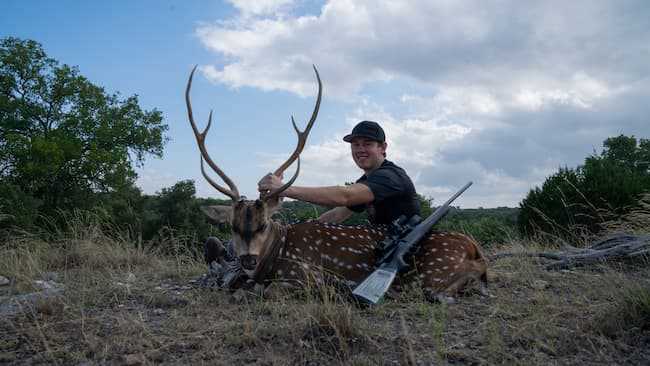Texas offers opportunities to tag some stunning species you won’t find anywhere else in the United States. But is shooting exotics in the Lone Star State really hunting?

Axis deer to zebra to aoudad — Texas ranches hold dozens of exotic fowl and mammal species hunters can chase throughout the year. Outfitted hunts range from relatively affordable DIY packages to fully guided, high-fence outings with luxury accommodations.
While some hunters appreciate the opportunity to take a newbie on an easier hunt or notch another species off the bucket list, others refuse to shoot exotics and label these ranches zoos rather than legitimate hunting operations.
Although these exotics were introduced to the state, some species have escaped ranches over the years, thrived in the wild, and now boast healthy free-range populations in many areas of the state. Axis deer, aoudad, and blackbuck are a few of the most common free-ranging exotic species you’ll find in Texas.
So arrowing one of these animals roaming the wide open spaces? That’s still fair chase.
But bowhunting a penned kudu, rhea, or zebra? Not so much.
Sure, while it may not be as challenging as fence-free hunting, it’s not like shooting fish in a barrel either — not usually. Some of these ranches span tens or even hundreds of thousands of acres. So it can still be a bit of a challenge depending on where you book.
But if you want a genuinely fair chase hunt you can feel great about, look for an outfitter that offers free-range exotic hunts without the high fences. It’s not a zoo without “cages.”

Greetings from a Hunter. Go for the stuff no one cares about. Racoon, Boar, invasive pests. Go for squirrel. You will have exciting hunts without driving thousands of miles, without paying big bucks to cull some half domesticated animal.
Mel83, they’re definitely great for a close-to-home hunt!
I might be interested in what they taste like (the exotics not the raccoons or invasive pests), because that is my dividing line on hunting. I don’t kill things I don’t intend to eat.
I doubt they would be much different than a local species that eats the same diet. If they browse, then much lie a deer,, if they graze,, more like black tail. I think the size of the animal makes a difference, too. I have had antelope and blacktail from the same area and I notice a slight difference,,, but an elk in the same area has a much different flavor.
Who knows,, I doubt I’ll find out unless someone gives me some that they harvested ( hint).
Axis deer is delicious!
Had a nice elk steak at a restaurant in N Carolina a few years back – first time trying it; it was very flavorful. Edible pest-wise around here (S Florida), not ready to try iguana yet.
FM,
Heard that the recipe used for Mergansers (a small fish eating duck) is suitable for Iguanas…
Clean and skin the merganser; plank the duck; rub with oil and salt; cook over an open fire until the plank is well scorched; discard the duck and eat the plank 😉
Saw one video where they cooked up a couple of Iguanas and their recipe was not far off the one for mergansers… they used enough strong spice and hot sauces to tenderize an old boot. I was surprised that it didn’t dissolve the pan or spontaneous ignite LOL!
Hank
There is a video on YouTube of an iguana air gun hunt in Puerto Rico, where the participants would eat the catch afterwards – reviews seemed to be mixed; apparently they tasted best when marinated in sour orange juice for several hours. Around here, have noticed the predators and carrion-eaters don’t seem particularly attracted to them. I’ll stick to chicken for now.
Iguana is not on my hunting list for this very reason!
Hunting domestically raised, or cage/fenced exoctics doesn’t pass my test for humane hunting. On those rare times when I hunt, it’s for food. The mounting of trophy heads in my den just doesn’t pass my masculine test. The culling of either pests or over populated species is a necessary responsibility. Orv.
Sourcing your own meat is definitely the biggest reason many hunt!